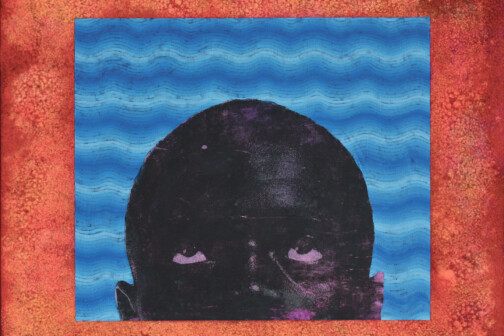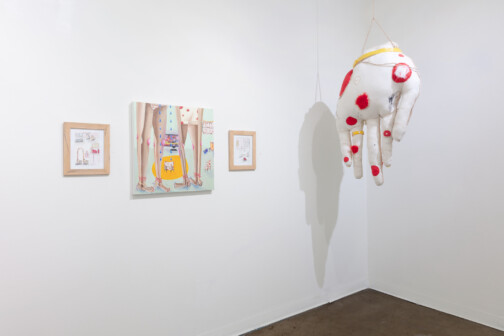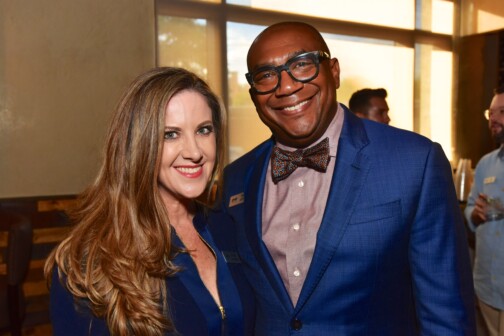Like certain other galleries—Erin Cluley, for example—Conduit has a project space that fosters rising talent as well as exhibitions that require an idiosyncratic installation. It’s a rare treat to find a rapport between the two main-gallery artists and the denizen in what’s known as the Project Room.
Currently, Conduit is hosting a gem of a trio. Dealing with form, identity, memory, and loss, they’re each strikingly different, but powerful together. Don’t miss it.
Stephen Lapthisophon’s Specters
Lapthisophon’s paintings might at first glance remind you of abstract expressionists such as Jackson Pollock or Robert Motherwell, the master of ghostly looming. Lapthisophon begins many of his works by placing them on the floor with a pouring gesture. He then layers them with dirt, soot, coffee grounds, newspaper, spray paint, house paint, oil stick, chocolate, or pigmented bacon fat.
He is a maximalist of materials, though a minimalist of color. This work veers toward stark black and white. A scrum of elements creates textures. They mingle in a tattoo of surface effects. In one, coffee grounds resemble a scab or a spray of stars as they catch the light. In another, a ghostly figure appears from blurred gestures of spray paint—a black silhouette on light hues. You can often see fugitive figures amid the abstractions.
Lapthisophon feels that his paintings are actions rather than compositions, accumulations of everyday things. But they’re held in extraordinarily taut, strong compositions. It’s why you can look at them again and again. This alchemist of the mundane, this sleuth of surfaces, treats the canvas like an improvisation. Materiality and immateriality collide, and they remain a dynamic enigma.
As a longtime figure in the art community (and a professor at UT Arlington), Lapthisophon is eminently worth revisitingin this tenth solo show with Conduit.

Johnny Floyd’s Son Prism
The sudden loss of his grandmother, who raised him, was the catalyst for the works in Johnny Floyd’s second solo show at Conduit. (The first show, in 2021, sold out, which was followed by a spot at TWO x TWO and an acquisition by the Dallas Museum of Art.) Son Prism, then, is about healing and recovery. Dreamlike paintings often blend photo transfers with oil and acrylic and a new array of mediums that lend dimensionality in the form of crackling, slight opacity.
Vibrating neon hues of green and pink seem to harness energy and create their own frequencies. In their symmetry and motifs of concentric semicircles, they evoke mandalas or altars and hold the figures in compositional harmony. Repetition creates ripples. And indeed, it is about the ripple effects of grief, but also the expansiveness of healing: not a dirge, but a song of hope.
In every painting, whether because they are sectioned off dramatically or silhouetted, the faces are obscured.
“Black men aren’t really allowed the space to do this kind of self-healing work, whether in our culture as Black men or the wider, broader culture,” Floyd says over the phone. Unconsciously, he has given his subjects autonomy, protection, and privacy.
As a whole, Son Prism is a jubilation and a balm. It is not to be missed.

Leonor Ali’s Body Language
Ali has created a cheeky dialogue in the gallery’s Project Room between her paintings and the quirky soft sculptures she crafted during the pandemic lockdown. A little bit Annette Messager, a little bit Cartoon Network, her work offers a blunt and frank appraisal of the body, complete with boils and pimples. Ali’s interest in blemished bodies is informed by living with polycystic ovary syndrome (PCOS), which causes excessive hair growth, hormone changes, and acne.
In her paintings, shades of mauve and teal clash with fire-engine red. In the hand- and machine-sewn soft sculptures, often using reclaimed fabrics, Ali makes statements that are funny, whimsical, and lighthearted with a soupcon of darkness. She eschews beauty to place the body in a different frame of judgment. And in the grotesque, she liberates the imagination. (I want a world where a subject’s flaws are as red as her panties.)
Hers is a world where saggy, stuffed breasts in faux red lingerie dangle comically against one wall. A larger-than-life, black velvet platform shoe, bedazzled with yellow stars, holds a squishy manicured suede foot likewise covered with painful-looking (but beautiful) woolen boils.
It’s a juicy constellation of body parts. And it does what some art does best: offer a reality check. Ali is also a brilliant example of the kind of work that functions perfectly in the tiny Project Room: turn the corner and joyfully enter her reality.
All three shows are on view at Conduit Gallery until March 25, 2023. See hours and information here.
Also See:
Candy Factory
Silkscreens based on Polaroid photographs, rendered in candy colors, are the center of an exhibition highlighting a collaboration between the late Genesis Breyer P-Orridge and Eric Heist. Blurry body parts, like anatomy pressed onto a copy machine—are they knees or fingers or breasts?—fill the frame in a pitch-perfect installation that brings their luscious ambiguity to the fore.
On view until March 25, 2023.
A Line Has Two Sides
The polyvalent, Los Angeles-based artist Meg Cranston is the second artist exhibited in Dallas by the gallery that recently moved from LA. In her new Palette Paintings, color swatches float, luminous, against neutral gray, while a site-specific horizon-line drawn onto the gallery walls—and to be traced with one’s finger—suggests spatial specificity and yet creates a subtle disorientation.
On view until April 8, 2023.
Get the FrontRow Newsletter
Author






